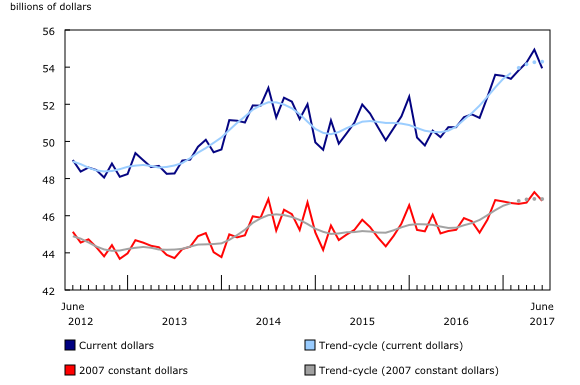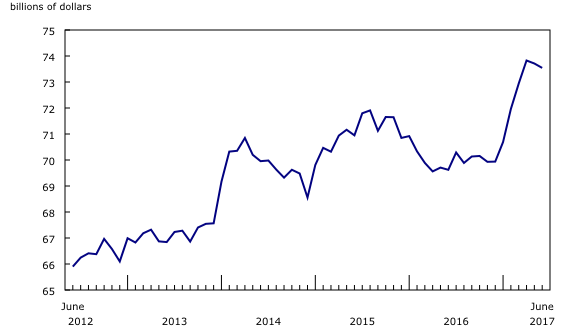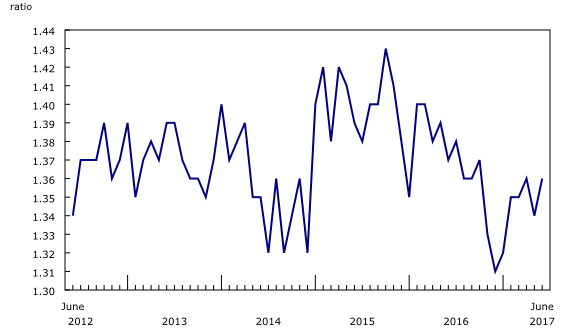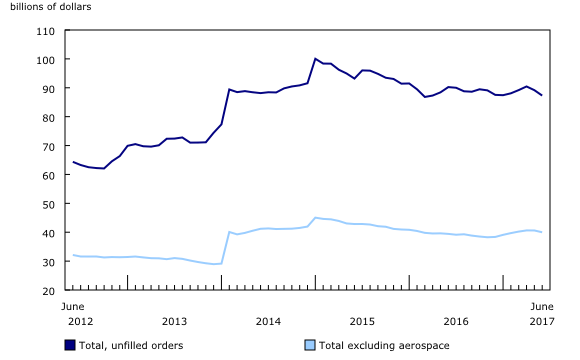Monthly Survey of Manufacturing, June 2017
Archived Content
Information identified as archived is provided for reference, research or recordkeeping purposes. It is not subject to the Government of Canada Web Standards and has not been altered or updated since it was archived. Please "contact us" to request a format other than those available.
Released: 2017-08-17
Manufacturing sales fell 1.8% to $53.9 billion in June, following three consecutive monthly gains. The declines were mainly due to lower sales in the petroleum and coal product, transportation equipment, and chemical industries.
Sales were down in 15 of 21 industries, representing 72.1% of the manufacturing sector in Canada. Sales of non-durable goods declined 2.2%, while sales of durable goods were down 1.5%.
In constant dollars, sales declined 1.0%, indicating that lower volumes of manufactured goods were sold in June.
Petroleum and coal product, transportation equipment, and chemical industries post the largest declines
Sales in the petroleum and coal product industry decreased 7.1% to $4.6 billion in June, following a 3.0% decline in May. Lower prices for petroleum and coal products (-4.1%) and lower volumes, particularly in eastern refineries, contributed to the decline in June. Constant dollar sales of petroleum and coal products fell 3.5%.
Sales in the transportation equipment industry declined 2.3% to $11.3 billion in June, following a 4.0% increase in May. Compared with June of last year, sales in the transportation equipment industry were up 5.1%. The declines in June 2017 were the result of decreases in the motor vehicle (-1.8%) and aerospace product and parts (-4.1%) industries.
Chemical industry sales fell 4.5% to $4.3 billion in June, after rising 2.6% in May. The declines in this industry were widespread and were most pronounced in pesticide, fertilizer and other agricultural chemical manufacturing. Sales in the chemical industry in June were up 3.6% compared with June 2016. In constant dollars terms, sales in the industry decreased 3.1% from May to June.
The declines were partially offset by higher sales in six industries, led by food (+0.7%) and machinery (+1.8%).
Sales down in Ontario and Quebec
Sales decreased in eight provinces in June, led by Ontario and Quebec.
Manufacturing sales in Ontario fell 1.7% (-$438 million) to $25.9 billion in June, following a 2.6% gain in May. The decline was the largest decrease in Ontario since May 2016, when sales fell $455 million. Despite the monthly decline in manufacturing sales in Ontario, sales were 4.1% higher in the province compared with June 2016. While 16 of 21 industries in Ontario reported lower sales in June, the largest decreases were observed in the motor vehicle manufacturing (-1.7%) and chemical (-4.9%) industries.
Sales in Quebec decreased 3.3% to $12.3 billion in June, following a 1.8% decline in the previous month. Fifteen of 21 industries in Quebec reported lower sales in June, led by petroleum and coal products, and aerospace products and parts. Despite the monthly decline, manufacturing sales in the province were up 4.5% compared with June 2016.
Sales in Alberta decreased 2.0% to $5.9 billion in June, after seven consecutive monthly increases. Much of the decline stemmed from the petroleum and coal product industry and the chemical industry.
Manitoba and British Columbia were the two provinces with higher manufacturing sales in June. Sales in Manitoba rose 6.0% to $1.6 billion, the third consecutive monthly increase. Year over year, sales in Manitoba were up 11.9%. Higher sales in the transportation equipment, food, and primary metal industries were responsible for the gains in June.
In British Columbia, sales were up 0.9% to $4.2 billion in June, mainly as a result of gains in the petroleum and coal product, electric equipment and appliance, and machinery industries. The increases were partly offset by declines in the transportation equipment and wood products industries.
Inventory levels edge down
Manufacturing inventories edged down 0.2% in June, for the second consecutive month. Inventories declined in 6 of 21 industries, with the petroleum and coal product industry posting the largest decline (-7.4%). The decreases were partially offset by higher inventories in 15 industries, led by a 1.2% gain in the primary metal industry.
The inventory-to-sales ratio increased from 1.34 in May to 1.36 in June. This ratio measures the time, in months, that would be required to exhaust inventories if sales were to remain at their current level.
Unfilled orders declined
Unfilled orders fell 2.1% to $87.3 billion in June. Transportation equipment, along with computer and electronic product manufacturing, were the main industries behind the decrease. An increase in unfilled orders in the chemical industry partially offset the declines.
New orders were down 3.0% to $52.1 billion in June, following a 3.3% decline in May. Seventeen of 21 industries posted lower levels. The decreases in new orders were more pronounced in the fabricated metal product, petroleum and coal product, and transportation equipment industries.

In celebration of the country's 150th birthday, Statistics Canada is presenting snapshots from our rich statistical history.
Furniture Manufacturing
The history of furniture making in Canada began with the Indigenous peoples, who built simple handmade furnishings long before Europeans arrived.
The 1666 Census in New France indicated that of the 3,215 European inhabitants in the colony, 27 were joiners and 36 were carpenters. These individuals would have constructed homes and a variety of basic furniture pieces for the colony's residents. In 1830, Jacob Hoffman opened Canada's first furniture factory in Berlin, Ontario (now Kitchener), and the industry started to slowly expand in Ontario and Quebec.
Following the Second World War, furniture manufacturing became more automated, and annual sales reached $641.6 million in 1967. By 2002, furniture sales were 20 times higher than in 1967, reaching an all-time high of $13.9 billion. In 2016, Canada was the world's eighth-largest furniture exporter, with annual sales of $11.5 billion. Also by 2016, there were an estimated 7,087 furniture manufacturers across Canada, 97% of which were Canadian-owned and operated.
Sources: CANSIM tables 304-0003 and 304-0014.
Note to readers
Monthly data in this release are seasonally adjusted and are expressed in current dollars unless otherwise specified.
For information on seasonal adjustment, see Seasonally adjusted data – Frequently asked questions. For information on trend-cycle data, see Trend-cycle estimates – Frequently asked questions.
Non-durable goods industries include food, beverage and tobacco products, textile mills, textile product mills, clothing, leather and allied products, paper, printing and related support activities, petroleum and coal products, chemicals, and plastics and rubber products.
Durable goods industries include wood products, non-metallic mineral products, primary metals, fabricated metal products, machinery, computer and electronic products, electrical equipment, appliances and components, transportation equipment, furniture and related products, and miscellaneous manufacturing.
Production-based industries
For the aerospace and shipbuilding industries, the value of production is used instead of the value of sales of goods manufactured. The value of production is calculated by adjusting monthly sales of goods manufactured by the monthly change in inventories of goods in process and finished products manufactured. The value of production is used because of the extended period of time that it normally takes to manufacture products in these industries.
Unfilled orders are a stock of orders that will contribute to future sales, assuming that the orders are not cancelled.
New orders are those received, whether sold in the current month or not. New orders are measured as the sum of sales for the current month plus the change in unfilled orders from the previous month to the current month.
Manufacturers reporting in US dollars
Some Canadian manufacturers report sales, inventories and unfilled orders in US dollars. These data are then converted to Canadian dollars as part of the data production cycle.
For sales, based on the assumption that they occur throughout the month, the average monthly exchange rate for the reference month (noon spot rate) established by the Bank of Canada is used for the conversion. The monthly average exchange rate is available in CANSIM table 176-0081. Inventories and unfilled orders are reported at the end of the reference period. For most respondents, the noon spot exchange rate on the last working day of the month is used for the conversion of these variables.
However, some manufacturers choose to report their data as of a day other than the last day of the month. In these instances, the noon spot exchange rate on the day selected by the respondent is used. Note that because of exchange rate fluctuations, the noon spot exchange rate on the day selected by the respondent can differ from both the exchange rate on the last working day of the month and the monthly average exchange rate. Noon spot exchange rate data are available in CANSIM table 176-0080.
Revision policy
Each month, the Monthly Survey of Manufacturing releases preliminary data for the reference month and revised data for the three previous months. Revisions are made to reflect new information provided by respondents and updates to administrative data.
Once a year, a revision project is undertaken to revise multiple years of data. Statistics Canada will release revised monthly manufacturing data on September 19, 2017, in accordance with standard practices. Sales of goods manufactured, inventories and orders in current dollars will be revised back to January 2014 for unadjusted data and to January 2012 for seasonally adjusted and constant dollar data.
Real-time CANSIM tables
Real-time CANSIM tables 304-8014, 304-8015 and 377-8009 will be updated on August 28. For more information, consult the document Real-time CANSIM tables.
Next release
Data from the Monthly Survey of Manufacturing for July will be released on September 19.
Products
For more information, contact us (toll-free 1-800-263-1136; 514-283-8300; STATCAN.infostats-infostats.STATCAN@canada.ca).
Contact information
To enquire about the concepts, methods or data quality of this release, contact Bechir Oueriemmi (613-951-7938; bechir.oueriemmi@canada.ca) or Michael Schimpf (613-863-4480; michael.schimpf@canada.ca), Manufacturing and Wholesale Trade Division.
- Date modified:







